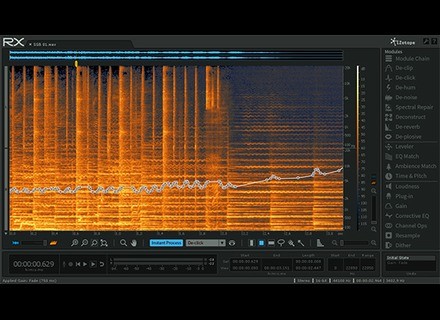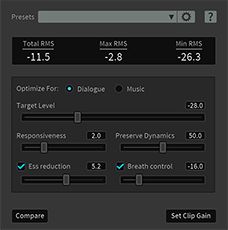To setup RX for use with RX Monitor: In the RX Standalone application, click Edit Preferences. Click the “Audio” tab. In the “Driver Type” dropdown menu, select “RX Monitor.” Click OK. To setup your DAW for use with RX Monitor: In your DAW, add an “aux” track. Audition CC 2018, Ableton Live 9–10, Cubase 9.5, Digital Performer 9, Final Cut Pro X., FL Studio 12, Logic Pro X, Nuendo 8, Premiere Pro CC 2018, Pro Tools 10–12, Reaper 5, Reason 10, Studio One 3–4.RX 7 is intended to be used as Final Cut Pro X’s default audio editor. When you first download and install RX 5 Audio Editor, it will be in Trial mode. After 30 days the product will go into Demo mode. Authorization is required to disable both Trial and Demo modes. Trial mode For the first 30 days after RX 5 Audio Editor is opened or instantiated, RX 5 Audio Editor will run in Trial mode.
| Plug-in Only |
|---|
Overview
When using the RX Connect plug-in, some DAW/NLEs monopolize the system’s audio drivers, preventing RX from playing audio through the same output device.
The RX Monitor plug-in allows you to listen to the output of the RX Audio Editor through the audio driver output of your host application. This is particularly useful when using RX Connect with a host application that would need to be closed for the RX Audio Editor to access the output driver it is using.
Workflow
- Insert the RX Monitor plug-in on an Aux or Instrument track in your DAW/NLE. When you first insert the RX Monitor plug-in, you will see a “Status: Disconnected” message. You need to configure RX Monitor as the Audio Driver in the RX Audio Editor to change the status to “Connected”
- Change the Audio Driver in the RX Audio Editor:
- Open Preferences
- Select the Audio tab
- In the “Driver Type” dropdown menu, select “RX Monitor”
- Open Preferences
- Navigate back to your host application and confirm the RX Monitor plug-in is showing a “Connected” status
- Playback audio in the RX Audio Editor, the output will be routed to the track you added RX Monitor to in your DAW/NLE.
Note
If you are running virus protection software or a firewall on your DAW, you may need to grant permission for RX Monitor to run.
Understanding the Preferences menu
Audio
Driver Type
Allows you to select a sound card driver model to use for playback and recording.
Note: Some hardware devices monopolize the audio drivers when sending audio clips to RX via RX Connect. If you are not able to hear the audio sent to RX from your DAW via RX Connect, change the audio driver to RX Monitor in the Driver type menu. See RX Monitor.
The rest of the dialog contains settings for your audio device and also includes a test tone generator.
Input/Output Device
Choose the device/sound card you want RX to use for playback and recording.
Buffer Size
The total playback buffer size. In general, lowering these buffer sizes will improve meter responsiveness and lower latency, but increase CPU needs. Raising buffer sizes will lower CPU cost but increase latency. It's worth exploring these ranges to find values that work best on your system.
Num Buffers
Number of playback sub-buffers. (MME Only.)
Channel Routing
For ASIO and CoreAudio drivers, click this button to choose which input and output channels RX uses. Click the Channel Routing button to open the Channel Routing dialog box.
Configure Driver
Launches the manufacturer’s driver configuration dialog.
Release when not in use
Auto-closes the audio device when playback in RX stops, freeing it for use in other audio applications. Disable this if playback from RX isn’t responsive enough.
Test Tone
The test tone generator is useful for testing your speakers, audio hardware and listening environment. Tones at set frequencies or at a custom frequency can be used as test tones, as can white or pink noise. In addition, a Channel Identification mode will identify left and right speakers.
Enable
Starts playback of a test tone.
Type
Sets the type of test tone to play.
Volume
Sets the volume of the test tone.
Frequency
Sets the frequency of the test tone.
Output Gain
Output gain allows you to nondestructively adjust the playback level of RX 5 Audio Editor.
Display
Show tooltips
When enabled, hovering over an RX feature with the mouse cursor will show a short description of the feature.
Display cursor coordinates in status bar
When this is enabled, the time coordinate of the cursor is shown in the status bar at the bottom of the RX main window. The amplitude of the audio at the cursor position and the frequency at the cursor position is also shown.
Show analog waveform
When digital audio is played back, it is converted to analog. The peak values in the analog waveform can be larger than the peaks in the digital waveform, leading to clipping in the output of a digital-to-analog converter. When Show analog waveform is enabled, RX will compute an analog waveform in the background. Any peaks will be highlighted in red on top of the existing digital waveform.
At very extreme zoom levels, RX always displays an analog waveform.
Offload waveform calculations
When this is enabled, RX's waveform display will be computed in the background. This allows very large files to be loaded very quickly, but it slows down RX's waveform displays.
Waveform interpolation order
If you zoom into the waveform so that individual samples become visible, RX will display an upsampled analog waveform as well as the individual digital samples. The interpolation order controls the quality of upsampling. Higher values yield more accurate analog waveforms at the expense of CPU usage.
Brightness
Adjusts the general brightness of the RX interface, allowing you to make RX more readable on your specific display.
Floating window opacity
Changes the opacity for RX's floating windows. This can be useful if you wish to leave floating windows on top of the spectrogram and waveform without completely obscuring the display.
Keyboard Shortcuts
While RX includes default keyboard shortcuts, you can also customize them to your liking.
Presets
Save groups of key assignments with this tool.
Show commands containing
Lets you search by keyword for a command you want to assign to a keystroke.
Shortcuts for selected command
Shows if there are any keystrokes assigned to the command selected in the above menu.
Remove
Removes the currently assigned keystroke from a command.
Press Shortcut Key
To assign a new keystroke to a command, select the command from the menu, then click in this field and press a key or combination of keys.
Assign
Assigns the entered keystroke to the current command. The shortcut will only be assigned to the current command if you press this button.
Shortcut key currently used by
Lists commands that the current keystroke is assigned to.
Note: On Windows systems, by default, 'Alt + a letter' will open the corresponding menu for your currently open application. Alt + V for example will open RX's View menu drop down. By default, none of RX's shortcuts should conflict with these keyboard shortcuts, however if you wish to assign Alt + V to another operation, it will take precedence over the View menu.
Miscellaneous
Session data folder
Allows you to choose a different folder to save RX's temporary session data. These files are created to allow actions to be undone and sessions to be recalled in RX. Because these can be very large, it is best to set this to the drive on your computer with the most free space.
Time scale frame rate
This sets the frame rate used to draw the time scale when RX is set to display the time code (see View menu or right-click the time ruler to change this setting). Choose from a list of standard frame rates or click in the combo box to define a custom frame rate.
Default full-bandwidth paste mode
This controls RX's behavior when pasting a full-bandwidth audio selection. Insert will move aside existing audio, Replace will overwrite existing audio, and Mix will add to existing audio.
Izotope Rx 7 Torrent Windows
Default limited-bandwidth paste mode
Similar to the full-bandwidth paste mode, this controls RX's behavior when pasting a limited-bandwidth audio selected.
Resume last editing session when app starts

On RX's start-up, the last audio file will be reloaded along with full history list of any edits made.
Automatically open files ending with .L and .R as split stereo
Mono audio files with (.L and .R) as well as (.1 and .2) extensions will be opened as stereo files when this option is enabled.
Recall selections during undo/redo
When this is enabled, RX will recall the selection used for an item in the undo history. When browsing the undo history, the selected region will be restored along with the audio.
Sometimes it is useful to turn this off if you need to compare undo history items and not break your current selection (like a useful loop).
Play only selected channels
If only a single channel of audio is selected and this option is enabled, all other channels will be muted during playback.
Calculate RMS using AES-17
Uses the AES-17 1998 standard for RMS calculations (0 dB is a full scale sine wave) in the level meter, Waveform Statistics and Leveler modules. The other option is when 0 dB is the RMS of a full-scale square wave. These options differ by 3 dB.
Pre- and Post-Roll during preview (ms)
When Previewing audio processing in any module, the specified time amount will be added to the beginning and end of the previewed selection in order to provide contrast between unprocessed and preview-processed audio.
Selection Feathering (ms)
This control allows for crossfading of processed and unprocessed audio when processing. If you need to make more precise edits, set this to 0.
Authorization & Updates
This tab enables you to authorize and deauthorize the software, as explained Authorization.
Plug-ins
Use these options to manage your third party audio processing plug-ins.
VST/Audio Unit/DirectX plug-ins
These areas show what plug-ins are available for the specified format, which may vary depending on your OS. You can also enable or disable every plug-in for the specified format using the Enable/Disable button.

VST plug-in folders
Lets you add or remove custom VST plug-in folders. RX uses the system VST plug-in folder by default. If your VST plug-ins do not show up, try using this option to add the directory where they are kept.
RX will also scan the first level of subfolders in this folder. If some of your plug-ins do not show up when you scan them, and you know they’re in a subfolder of your plug-in folder, try moving them up one directory level.
Group plug-ins by name in plug-in menus

When enabled, the RX plug-in menu will group plug-ins by common first words, usually the manufacturer’s name.
Izotope Rx 7 Free Download
When disabled, the RX plug-in menu will appear as a single, alphabetically sorted list.
Rescan
Izotope Rx 7 Audio Editor Advanced
If RX detects that a plug-in is unstable, it will blacklist it and prevent it from being opened.
This option allows you to clear RX’s blacklist of unsupported plug-ins and rescan all installed plug-ins in case an RX update or an update from the plug-in manufacturer resolves the issue.